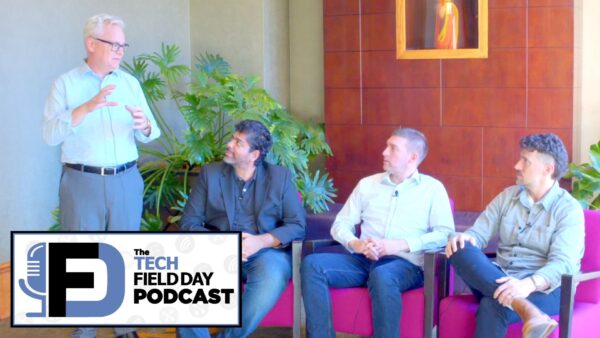Company Acquisitions are a Necessary Evil in Enterprise Tech
The IT industry’s reliance on acquisitions is a necessary driver of innovation, though they often seem to get in the way of competition and progress. This episode of the Tech Field Day podcast, recorded during Cloud Field Day 21, features Ray Lucchesi, Jon Hildebrand, Ken Nalbone, and Stephen Foskett considering whether acquisitions in the IT industry are a necessary evil or a detriment to innovation. Acquisitions are often seen as a double-edged sword, with both positive and negative implications. On one hand, acquisitions can fuel innovation by providing smaller companies with the resources and market access they need to scale their ideas. On the other hand, they can stifle competition, lead to cultural clashes, and sometimes result in the disappearance of promising technologies or products.
Apple Podcasts | Spotify | Overcast | Amazon Music | YouTube Music | Audio
See more from Cloud Field Day 21 on the Tech Field Day website or YouTube channel.
We May Not Like Acquisitions in Tech But We Need them!
The IT industry has long been shaped by the cycle of acquisitions, with large companies absorbing smaller, innovative startups to bolster their portfolios. This practice is often seen as a double-edged sword. On one hand, acquisitions can inject fresh ideas and technologies into established organizations, enabling them to stay competitive in a rapidly evolving market. On the other hand, the process can stifle innovation, as smaller companies with promising technologies are often absorbed and their products either languish or are subsumed into larger, less agile corporate structures. The debate over whether acquisitions are a necessary evil or simply detrimental to the industry remains a contentious topic.
One of the key arguments in favor of acquisitions is their role in fostering innovation. Startups often emerge with groundbreaking ideas but lack the resources or market reach to scale effectively. Being acquired by a larger company can provide the necessary capital, infrastructure, and customer base to bring these innovations to a broader audience. However, this process is not without its pitfalls. Many acquisitions result in a clash of corporate cultures, leading to inefficiencies and, in some cases, the eventual dissolution of the acquired entity’s unique value proposition. This raises questions about whether the industry might benefit more from encouraging organic growth rather than relying on acquisitions as a growth strategy.
Critics argue that acquisitions often prioritize short-term financial gains over long-term innovation. Large corporations may acquire smaller companies not to integrate their technologies but to eliminate potential competition. This practice can lead to market consolidation, reducing diversity and stifling the competitive landscape. Furthermore, the focus on financial returns, driven by venture capital and private equity investments, often pressures startups to position themselves as acquisition targets rather than sustainable, standalone businesses. This dynamic can skew the priorities of emerging companies, emphasizing exit strategies over product development and customer satisfaction.
The role of private equity in driving acquisitions adds another layer of complexity. Private equity firms often seek to maximize returns by cutting costs and streamlining operations, which can lead to a loss of innovation and employee morale within the acquired company. While some private equity firms take a more hands-on approach to foster growth and innovation, others focus solely on financial metrics, potentially undermining the long-term viability of the companies they acquire. This dichotomy highlights the need for a more balanced approach to investment, one that prioritizes sustainable growth and innovation over short-term financial gains.
In an ideal world, the IT industry would thrive on organic growth, with companies building sustainable business models and scaling through customer acquisition and market expansion. However, the reality is that acquisitions are deeply ingrained in the industry’s fabric, driven by the need for rapid growth and the financial incentives of venture capital and private equity. While acquisitions may be a necessary evil in the current landscape, the industry must strive to ensure that they are conducted in a way that fosters innovation, benefits customers, and supports the long-term health of the market. The challenge lies in finding a balance that allows both startups and established companies to thrive without compromising the industry’s overall dynamism.
Podcast Information:
Stephen Foskett is the President of the Tech Field Day Business Unit and Organizer of the Tech Field Day Event Series, now part of The Futurum Group. Connect with Stephen on LinkedIn or on X/Twitter.
Ray Lucchesi is the president of Silverton Consulting and the host of Greybeards on Storage Podcast. You can connect with Ray on X/Twitter or on LinkedIn. Learn more about Ray on his website and listen to his podcast.
Jon Hildebrand is an automation and observability expert. You can connect with Jon on LinkedIn or on X/Twitter. Learn more about Jon by reading his personal blog.
Ken Nalbone is a Senior Solutions Architect at AHEAD. You can connect with Ken on X/Twitter, Bluesky, and on LinkedIn. Learn more about Ken on his personal website.
Thank you for listening to this episode of the Tech Field Day Podcast. If you enjoyed the discussion, please remember to subscribe on YouTube or your favorite podcast application so you don’t miss an episode and do give us a rating and a review. This podcast was brought to you by Tech Field Day, home of IT experts from across the enterprise, now part of The Futurum Group.
#CFD21 #TFDPodcast #GestaltIT #KenNalbone #RayLucchesi #SFoskett #SnoopJ123 #TechFieldDay #TechFieldDayPod
